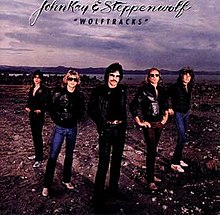Rock and roll music
| Wolftracks | ||||
|---|---|---|---|---|
 | ||||
| Studio album by | ||||
| Released | 1982 | |||
| Recorded | 1982 | |||
| Studio | Ocean Way, Hollywood, California | |||
| Genre | Rock | |||
| Length | 45:09 | |||
| Label | Wolf | |||
| Producer | John Kay, Richard Podolor | |||
| Steppenwolf chronology | ||||
| ||||
| Singles from Wolftracks | ||||
| ||||
No videos available

Álbums chronology
Wolftracks
Steppenwolf
Discográfica: Wolf · Estudio de grabación: Ocean Way, Hollywood, California · Productor: John Kay , Richard Podolor
From Wikipedia, the free encyclopedia
Leer más
Review
From Wikipedia, the free encyclopedia
Leer más
For other uses, see Wolf Tracks (disambiguation).
1982 studio album by Steppenwolf
Wolftracks is an album by John Kay and Steppenwolf, released in 1982 by Wolf Records, with distribution by Nautilus Records in the U.S. and Attic Records in Canada.[1] It was the first new studio album in six years for John Kay, featuring a new line-up of Steppenwolf and Kay renaming the group accordingly.
Background
In 1980, John Kay reclaimed the Steppenwolf name, touring as “John Kay & Steppenwolf.” The album Wolftracks, the first after the band reformed, was recorded "live" in the studio on a 2-track digital recorder, which was then a new medium.[2]
Critical reception
| Review scores | |
|---|---|
| Source | Rating |
| AllMusic | [3] |
| The Rolling Stone Album Guide | [4] |
The Globe and Mail wrote that "the basic elements are all there: Kay`s husky, Wilson Pickett singing style dominates the digitally processed mix, and Michael Wilk adds the familiar, fat organ sounds to the lurching, half-soul and half-rock beat."[5]
Track listing
Side one
- "All I Want Is All You Got" (John Kay) – 3:55
- "Time" (Kay, Michael Palmer, Kevin Kern) – 3:31
- "None of the Above" (Kay, M. Palmer, Steven Palmer) – 5:59
- "You" (Kay) – 3:50
- "Every Man for Himself" (Kay) – 3:19
- "Five Finger Discount" (Kay) – 4:36
Side two
- "Hold Your Head Up" (Rod Argent, Chris White) – 3:42
- "Hot Night in a Cold Town" (Rick Littlefield, Geoffrey Cushing-Murray) – 3:20
- "Down To Earth" (Kim Fowley, Ross Wilson) – 3:00
- "For Rock-N-Roll" (Kay) – 3:42
- "The Balance" (Kay) – 6:15
Personnel
John Kay and Steppenwolf
- John Kay – guitar, vocals
- Michael Wilk – keyboards, vocals
- Michael Palmer – lead guitar, vocals
- Welton Gite – bass
- Steven Palmer – drums, percussion, vocals
Additional musicians
- Brett Tuggle, George Biondo – backing vocals
Technical
- John Kay – producer
- Richard Podolor – producer (track 1)
- Kevin Kern – engineer, assistant producer
- Rich Feldman – engineer
- Mark Ettel, Steve Crimmel – assistant engineers
- Bruce Leek, Richard Donaldson – mastering
- Drennon Studio – art direction
- John Exley – photography
From Wikipedia, the free encyclopedia
For other uses, see Wolf Tracks (disambiguation).
1982 studio album by Steppenwolf
Wolftracks is an album by John Kay and Steppenwolf, released in 1982 by Wolf Records, with distribution by Nautilus Records in the U.S. and Attic Records in Canada.[1] It was the first new studio album in six years for John Kay, featuring a new line-up of Steppenwolf and Kay renaming the group accordingly.
Background
In 1980, John Kay reclaimed the Steppenwolf name, touring as “John Kay & Steppenwolf.” The album Wolftracks, the first after the band reformed, was recorded "live" in the studio on a 2-track digital recorder, which was then a new medium.[2]
Critical reception
| Review scores | |
|---|---|
| Source | Rating |
| AllMusic | [3] |
| The Rolling Stone Album Guide | [4] |
The Globe and Mail wrote that "the basic elements are all there: Kay`s husky, Wilson Pickett singing style dominates the digitally processed mix, and Michael Wilk adds the familiar, fat organ sounds to the lurching, half-soul and half-rock beat."[5]
Track listing
Side one
- "All I Want Is All You Got" (John Kay) – 3:55
- "Time" (Kay, Michael Palmer, Kevin Kern) – 3:31
- "None of the Above" (Kay, M. Palmer, Steven Palmer) – 5:59
- "You" (Kay) – 3:50
- "Every Man for Himself" (Kay) – 3:19
- "Five Finger Discount" (Kay) – 4:36
Side two
- "Hold Your Head Up" (Rod Argent, Chris White) – 3:42
- "Hot Night in a Cold Town" (Rick Littlefield, Geoffrey Cushing-Murray) – 3:20
- "Down To Earth" (Kim Fowley, Ross Wilson) – 3:00
- "For Rock-N-Roll" (Kay) – 3:42
- "The Balance" (Kay) – 6:15
Personnel
John Kay and Steppenwolf
- John Kay – guitar, vocals
- Michael Wilk – keyboards, vocals
- Michael Palmer – lead guitar, vocals
- Welton Gite – bass
- Steven Palmer – drums, percussion, vocals
Additional musicians
- Brett Tuggle, George Biondo – backing vocals
Technical
- John Kay – producer
- Richard Podolor – producer (track 1)
- Kevin Kern – engineer, assistant producer
- Rich Feldman – engineer
- Mark Ettel, Steve Crimmel – assistant engineers
- Bruce Leek, Richard Donaldson – mastering
- Drennon Studio – art direction
- John Exley – photography





















